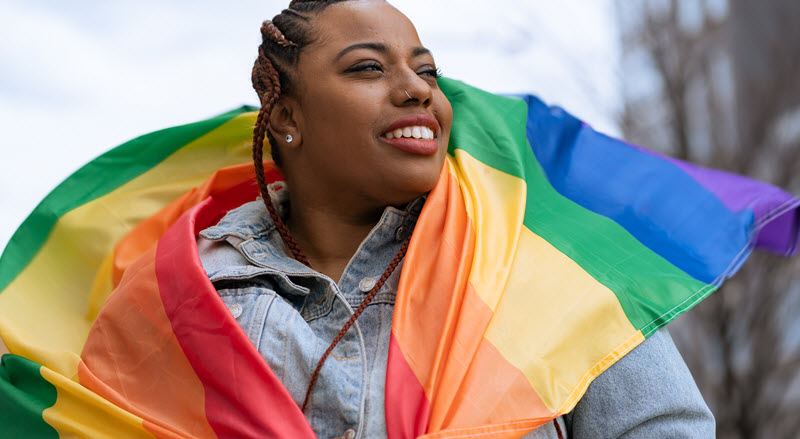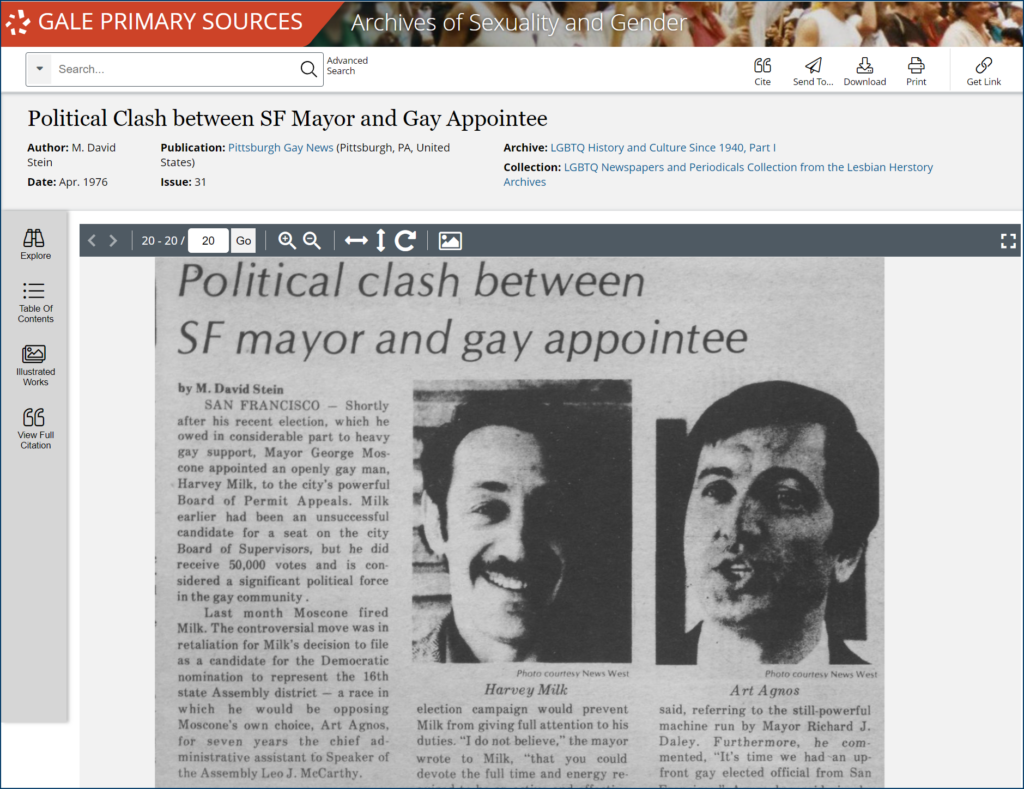| By Gale Staff |
At 1:20 a.m. on June 28, 1969, police raided the Stonewall Inn in Manhattan’s Greenwich Village, swarming the 205 people present. It wasn’t the first time. Typically, these raids targeted patrons that the police believed were assigned male at birth (AMAB) dressed as women. Female officers would take anyone wearing female-presenting clothing into the bathroom, make them remove their clothing to “prove” their sex, and arrest anyone they found in violation of New York obscenity laws.
That night, however, things did not go as planned. Unhoused LGBTQ youths sleeping in nearby Christopher Park gathered around the crowd and began lobbing garbage, bricks, pennies, and bottles at the police. It soon escalated into a full-scale brawl lasting nearly a week, during which many people were injured and arrested.
While certainly not the first time that the LGBTQ community had fought back against repression, the event catalyzed the gay rights movement. This led to the formation of many LGBTQ rights organizations, including GLAAD (formerly Gay and Lesbian Alliance Against Defamation) and PFLAG (formerly Parents and Friends of Lesbians and Gays).
Writings on Gay and Lesbian History Series 3. 1940-1997. Manuscripts Subseries 3.4. 1940-1997: Chronologies No Date. 1950-1968. MS Box 22, Folder 10, Jim Kepner Papers: Writings on Gay and Lesbian History Series 3. 1940-1997. ONE National Gay & Lesbian Archives. Archives of Sexuality and Gender (accessed March 18, 2024). https://link.gale.com/apps/doc/KQCMDN429023598/AHSI?u=seoblogs&sid=bookmark-AHSI&xid=fe1ac17b&pg=132.
The Stonewall uprising is one of the important events of the LGBTQ civil rights movement and the reason that we celebrate Pride every June. But, as is often the case with history, countless untold moments had a big effect on the drive toward LGBTQ rights. Unfortunately, uncovering those events can be challenging, leaving us with gaps in the story and voices left unheard.
Gale’s Archives of Sexuality and Gender is one of the most comprehensive databases on sex, sexuality, and gender. Across 52 collections spanning four centuries, students can dig into hundreds of thousands of rare primary sources, including periodicals, photographs, government documents, newsletters, private correspondence, and more. It’s a tool that invites users to better understand the complexity of the human experiences related to sex, gender, and identity through the words of those often silenced voices.
A Timeline of LGBTQ Victories, Firsts, and Accomplishments
To show you the depth and richness of the Archives of Sexuality and Gender, let’s take a look at the last century of the LGBTQ rights movement through the eyes of those who participated in it:
1924: After early LGBTQ activist Henry Gerber’s military stint in Germany, where the gay community was more open than in America, he returned to Chicago and founded the first gay rights organization in the nation: The Society for Human Rights. Unfortunately, Gerber’s efforts were short-lived. The police targeted him in a raid and threw him in jail after planting a powder puff that they used to accuse him of “effeminacy.” The Society for Human Rights was disbanded in 1925, just one year after it was founded.
1953: ONE, the first gay magazine in the United States, came into publication, leading to a standoff with the Los Angeles branch of the United States Postal Service after they refused to ship out the August issue covering gay marriage. The Post Office held back the issue for three weeks before DC officials ordered them to release the magazine, as it did not violate any federal laws.
1955: The first lesbian rights organization, the Daughters of Bilitis, was formed in San Francisco to host social events aimed at keeping members out of the city’s frequently raided lesbian bars.
1961: Illinois became the first state to decriminalize homosexual acts between consenting adults and in private—the same standards by which heterosexual acts were judged. It was a decade before Connecticut became the second state to do the same.
1969: During a police raid at The Stonewall Inn on June 28, the patrons and a crowd of residents in the neighborhood began rioting and sparked a six-day clash against law enforcement.
1970: In honor of the Stonewall uprising a year earlier, thousands gathered across Chicago, New York, and Los Angeles for the first Pride marches. Pride’s forerunner, the 1965–1969 Reminder Day pickets, were discontinued in favor of more militant and open demonstrations.
1974: Kathy Kozachenko became the first openly gay elected official when the 21-year-old beat her opponent by 52 points for a seat on the Ann Arbor City Council in Michigan.
1978: Harvey Milk, an openly gay man, took office on the San Francisco Board of Supervisors on January 9. His first act was a bill outlawing orientation-based discrimination, and Mayor George Moscone signed it into law. Both men were assassinated by a former supervisor, Dan White, on November 27 of the same year.
Stein, M. David. “Political Clash between SF Mayor and Gay Appointee.” Pittsburgh Gay News, no. 31 (1976): B4. Archives of Sexuality and Gender (accessed March 19, 2024). https://link.gale.com/apps/doc/HBPJKN813379298/AHSI?u=seoblogs&sid=bookmark-AHSI&xid=a647caa5.
1987: After years of classification as a mental illness, the American Psychiatric Association dropped homosexuality from the Diagnostic and Statistical Manual of Mental Disorders. In 1973, the APA decided that homosexuality would no longer be considered a “psychiatric disorder,” however it was merely redefined as a “sexual orientation disturbance” until 1987.
1990: After 23 years, the World Health Organization (WHO) removed homosexuality from the International Classification of Diseases.
2001: The Netherlands became the first nation to legalize marriage for same-sex couples on April 1. The then-mayor of Amsterdam, Job Cohen, acted as officiant for four same-sex couples that same day.
May 2004: Marcia Kadish and Tanya McCloskey became the first same-sex partners legally married in the United States. The wedding was held at Cambridge City Hall in Massachusetts on May 17.
June 2004: On June 24, activists in San Francisco held the first trans march in response to an anonymous email stating, in part, “We are calling for this march to demonstrate that we are a significant and growing portion of the lgbtiq community; to increase our visibility and presence in the lgbtiq community and the overall community at large.” The San Francisco Trans March is now one of the largest trans events in the world.
2010: The Senate voted to repeal Don’t Ask, Don’t Tell, the Clinton-era policy that prohibited gay people from serving openly in the military.
2015: The US Supreme Court ruling in Obergefell v. Hodges struck down state bans on same-sex marriage and required all states to recognize same-sex marriage licenses from out of state.
2016: Barack Obama designated the area around The Stonewall Inn and Christopher Park in Greenwich Village as the Stonewall National Monument.
2017: Danica Roem became the first openly transgender person to serve in a state legislature, the Virginia House of Delegates.
May 2019: The WHO replaced “transsexualism,” also called gender identity disorder and gender dysphoria, with “gender incongruence,” and reclassified the condition as a sexual health rather than a mental health condition. In doing so, they took a major step forward in depathologizing trans and gender-diverse identities.
June 2019: Harvey Milk became an inaugural inductee into the National LGBTQ Wall of Honor on the 50th anniversary of the Stonewall Uprising.
2020: A June 15 Supreme Court ruling concluded that members of the LGBTQ community are protected from discrimination under Title VII of the Civil Rights Act of 1964.
2022: President Joe Biden signed the Respect for Marriage Act into law on December 13, overturning the Defense of Marriage Act (DOMA). This decision codified federal rights and benefits of marriage to gay and interracial couples, ensuring that their union is recognized in every state.
Continuing the Fight for LGBTQ Equal Rights
While it is true that we have come so far in the last century, there is still more work to do.
In a 2023 report from the Center for American Progress, one of the most gut-wrenching findings is that more than 1 in 3 (36%) of LGBTQ adults have faced discrimination in the last year. The numbers are even starker for LGBTQ people of color (45%), LGBTQ people with disabilities (47%), transgender or nonbinary individuals (56%), and intersex individuals (67%).
When we feel overwhelmed or downtrodden, reading the stories of those who came before us reminds us that every bit of progress proves we can improve things: one march, one email, one conversation at a time.
Only Gale’s Sexuality and Gender Archive can offer such a comprehensive collection of primary sources from the LGBTQ community. Contact your local sales representative to learn more about what it can provide library patrons.



